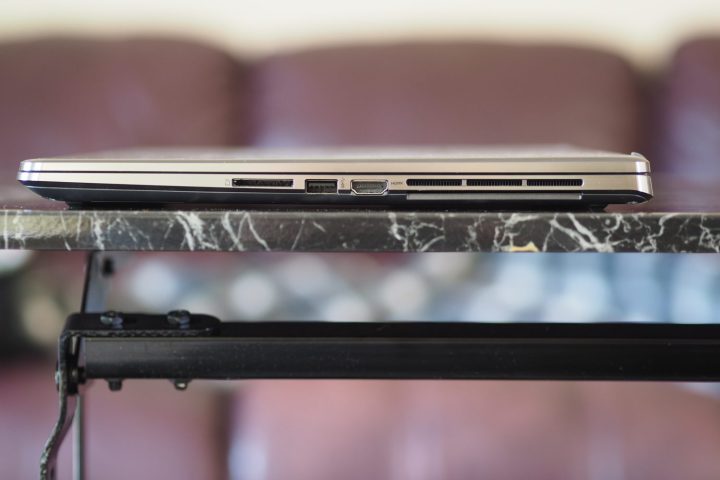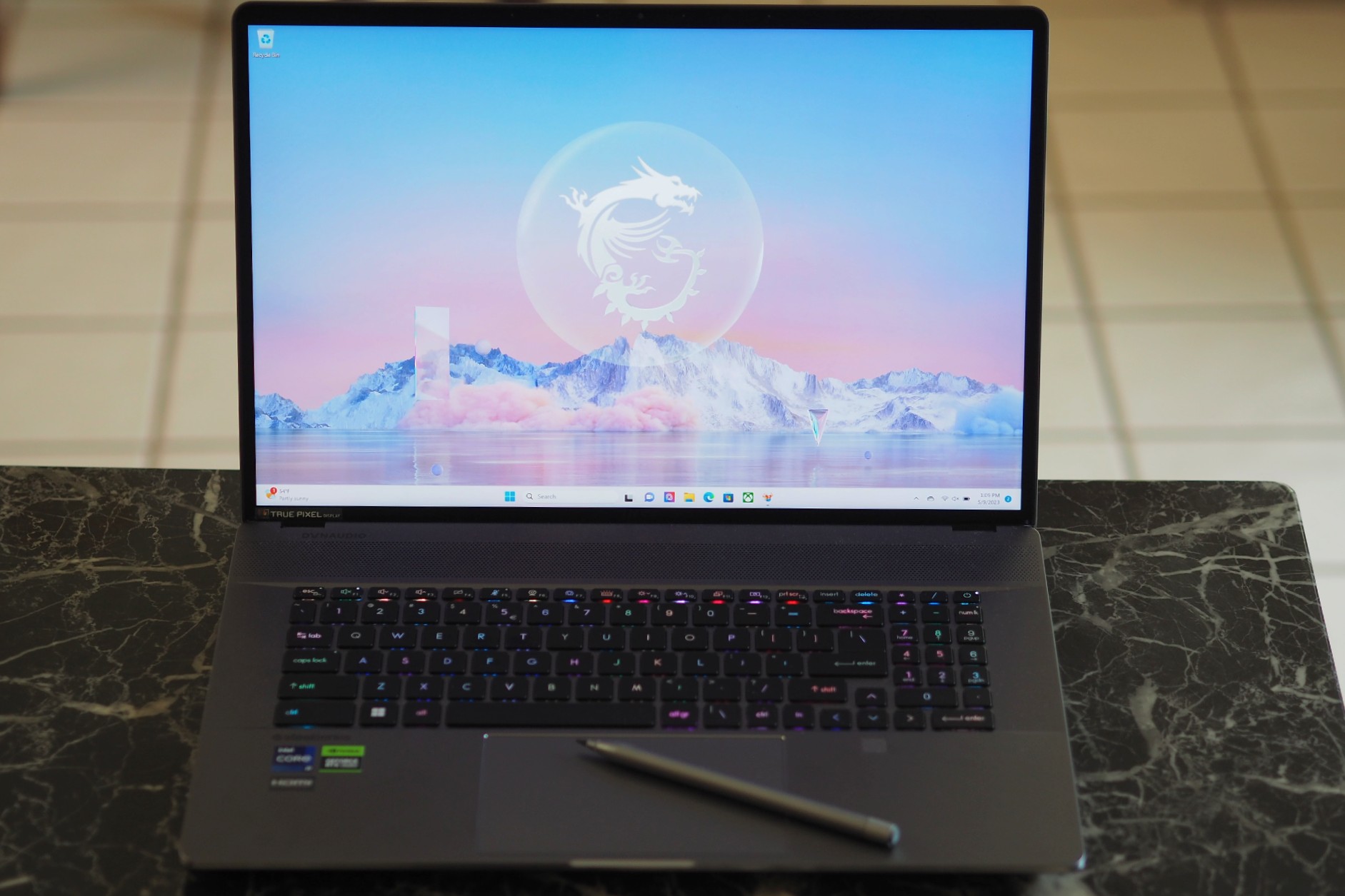
MSI Creator Z17 HX Studio
MSRP $3,600.00
“The MSI Creator Z17 HX Studio is a decent workstation for creators, but lacks a more powerful GPU.”
Pros
- Fast CPU performance
- Solid GPU performance, including gaming
- Rigid and relatively portable design
- Good keyboard with per-key RGB lighting
- Decent connectivity
- Innovative pen
Cons
- Expensive
- Would benefit from a faster GPU
- Touchpad is smaller than it could be
- Battery life is weak
MSI has an entire line of laptops, the aptly named Creator series, aimed directly at creative types. They incorporate fast CPUs and discrete GPUs to speed up creative tasks like photo and video editing. The Creator Z17 HD Studio is the latest, and it features the second-fastest Intel mobile CPU and a midrange Nvidia GPU.
It’s an expensive laptop, the cost of which is mitigated somewhat by its solid design and excellent performance. It’s even reasonably sized given its large 17.0-inch display. But there are a lot of machines at around the same price and with the same level of components. The Creator Z17 HD Studio does well, but it’s not the class leader.
Specs and configurations
| MSI Creator Z17 HX Studio | |
| Dimensions | 15.0 inches x 10.2 inches x 0.75 inches |
| Weight | 5.49 pounds |
| Processor | Up to Core i9-13980HX |
| Graphics | Nvidia GeForce RTX 4060 Nvidia GeForce RTX 4070 |
| RAM | Up to 64GB DDR5-5600 |
| Display | 17.0-inch QHD+ (2,560 x 1,600) IPS, 165Hz |
| Storage | Up to 2TB PCIe Gen5 SSD |
| Touch | Yes, with pen support |
| Ports | 2 x USB-C with Thunderbolt 4 1 x USB-A 3.2 Gen 2 1 x HDMI 2.1 1 x 3.5mm audio jack 1 x full-size SD card reader |
| Wireless | Wi-Fi 6E and Bluetooth 5.3 |
| Webcam | 1080p with infrared camera for Windows 11 Hello |
| Operating system | Windows 11 |
| Battery | 90 watt-hours |
| Price | $3,600 |
As of when this review is being written, MSI lists just one configuration of the Creator Z17 HX Studio. I reviewed the $3,600 model with a Core i9-13980HX CPU, 64GB of RAM, a 2TB SSD, a 17.0-inch QHD+ IPS display at 165Hz, and an Nvidia GeForce RTX 4070. That’s not cheap, but it’s within the same range as other high-end creator-oriented laptops. The configuration includes the MSI Pen 2 that can be used on both the display and a regular piece of paper. Note that the laptop includes a three-year warranty compared to the industry-standard single year.
Fast in productivity mode

I’ll cut straight to the chase and discuss the MSI Creator Z17 HX Studio’s performance (we’ll refer to it as the Creator Z17 from here on out). After all, that’s why you’d buy this beast of a laptop, because you’re a creator looking for a powerful portable workstation that can meet your demanding workflow. My review unit was equipped with the second-fastest Intel 13th-gen Raptor Lake mobile chip, the Core i9-13950HX. It’s a 55-watt, 24-core CPU with eight Performance cores running at 5.5GHz and 16 Efficient cores running at 4.0GHz, along with 32 threads. The only speedier mobile CPU is the Core i9-13980HX, which has slightly faster Max Turbo speeds.
MSI sent the laptop to me configured in performance mode, and as we’ll see, that was clearly for a good reason. I like to configure review units to be as identical as possible, so I created a new account and configured the machine as usual. That means running our benchmarks in normal and performance modes to see how aggressively a laptop is tuned for regular versus demanding work. With the Creator Z17, MSI obviously wants you to run it in performance mode whenever you’re doing real work, because the results are far more impressive when you turn things up.
Why would MSI bother to have a normal mode if it wants you to run in performance mode? It’s simple: the fans are much louder, and the chassis gets much warmer (although never hot) in the latter mode. If you’re not running hardcore tasks, you’ll appreciate normal mode’s (relative) quiet and coolness. I’ll note that the fans in performance mode sometimes emitted a piercing whistle that was quite distracting, but it didn’t happen often enough that it ruined the overall experience.

If you’re in performance mode, the Creator Z17 competes well against a comparison group that includes the very fast AMD Ryzen 9 7945HX. That’s a 55-watt 16-core/32-thread CPU running at up to 5.4GHz, and it led the pack in many of our benchmarks. Regarding CPU performance, though, the Creator Z17 is competitive across the board.
Even though it had a slower GPU, an RTX 4070 rather than the RTX 4080 and 4090 in some other machines, it still did well in the PugetBench Premiere Pro benchmark, which runs in a live version of Adobe’s Premiere Pro and uses the GPU to speed up various processes. The Creator Z17 beat the Asus ROG Strix Scar 17 with the AMD Ryzen 9 7945HX and an RTX 4090, likely thanks to various Intel optimizations in playback that increase the PugetBench results.
Interestingly, the Legion Pro 7i was quite competitive despite having a slower CPU and “only” an RTX 4080. It led the pack in the PugetBench benchmark and kept up with all but the ROG Strix Scar 17 in the CPU-intensive benchmarks. But even so, the Creator Z17 is a very fast performer that can keep up with the most demanding productivity and creative workflows.
| Geekbench (single / multi) |
Handbrake (seconds) |
Cinebench R23 (single / multi) |
Pugetbench Premiere Pro |
|
| MSI Creator Z17 HX Studio (Core i9-13950HX / RTX 4070) |
Bal: 2,005 / 15,786 Perf: 2,006 / 19,894 |
Bal: 61 Perf: 51 |
Bal: 1,968 / 19,992 Perf: 2,024 / 23,935 |
Bal: 725 Perf: 1,193 |
| Asus ROG Strix Scar 17 (Ryzen 9 7945HX / RTX 4090) |
Bal: 2,112 / 19,205 Perf: N/A |
Bal: 44 Perf: N/A |
Bal: 1,940 / 31,661 Perf: N/A |
Bal: 1,103 Perf: 1,170 |
| Lenovo Legion Pro 7i (i9-13900HX / RTX 4080) |
Bal: 2,020 / 19,041 Perf: |
Bal: 55 | Bal:2,096 / 22,596 Perf: |
Bal: 1.310 Perf: 1,441 |
| Dell XPS 15 (9530) (Core i7-13700H / RTX 4070) |
Bal: 1,787 / 11,978 Perf: 1,830 / 11,769 |
Bal: 79 Perf: 76 |
Bal: 1,865 / 13,386 Perf: 1,868 / 13,927 |
Bal: 709 Perf: 1.032 |
| Samsung Galaxy Book3 Ultra (Core i7-13700H / RTX 4050) |
Bal: 1,647 / 12,206 Perf: 1,815 / 12,307 |
Bal: 80 Perf: 74 |
Bal: 1,712 / 13,278 Perf: 1,908 / 14,938 |
Bal: 737 Perf: 975 |
| Apple MacBook Pro 14 (M2 Max 12/38) |
Bal: 1,973 / 14,596 Perf: N/A |
Bal: 85 Perf: N/A |
Bal: 1,608 / 14,789 Perf: N/A |
Bal: 1,222 Perf: N/A |
With a solid discrete GPU in the RTX 4070, you’ll likely want to run some games on the Creator Z17. And, again, if you run in performance mode, you’ll have a competitive gaming machine capable of running newer titles at up to 1440p with graphics turned up. It can’t keep up with the RTX 4080 and RTX 4090 machines, but that’s to be expected.
Note that in performance mode, the Creator Z17’s RTX 4070 draws 90 watts of power. That’s considerably more than the 40 watts allocated to the RTX 4070 in the Dell XPS 15 9530, the only other RTX 4070-equipped laptop we’ve tested. Accordingly, except in Assassin’s Creed Valhalla, the Creator Z17 was much faster in performance mode.
MSI loads up the Creator Z17 with Nvidia’s Studio drivers, which don’t provide the best gaming performance, but rather aim to enhance stability and make creative and other specialized applications perform faster. If you’re more worried about gaming, you can switch to Nvidia’s Game Ready drivers for a likely uptick in frame rates.
| Assassin’s Creed Valhalla (1080p Ultra High) |
Cyberpunk 2077 (1080p Ultra) |
Civilization VI (1080p Ultra) |
3DMark Time Spy |
|
| MSI Creator Z17 HX Studio (Core i9-13950HX / RTX 4070) |
Bal: 66 fps Perf: 101 fps |
Bal: 61 fps Perf: 90 fps |
Bal: 149 fps Perf: 191 fps |
Bal: 10,186 Perf: 11,630 |
| Asus ROG Strix Scar 17 (Ryzen 9 7945HX / RTX 4090) |
Bal: 156 fps Perf: 160 fps |
Bal: 101 fps Perf: 103 fps |
N/A | Bal: 18,690 Perf: 19,009 |
| Asus ROG Zephyrus M16 (Core i9-3200H / RTX 4090) |
Bal: 116 fps Perf: 136 fps |
Bal: 92 fps Perf: 109 fps |
Bal: 220 fps Perf: 276 fps |
Bal: 14,421 Perf: 18,372 |
| Lenovo Legion Pro 7i (i9-13900HX / RTX 4080) |
Bal: 125 fps Perf: 129 fps |
Bal: 114 fps Perf: 113 fps |
N/A | Bal: 12,874 Perf: 18,017 |
| Dell XPS 15 9530 (Core i7-13700H / RTX 4070) |
Bal: 65 fps Perf: 105 fps |
Bal: 60 fps Perf: 60 fps |
Bal: 131 fps Perf: 137 fps |
Bal: 7,077 Perf: 7,632 |
| MSI Creator Z16P (Core i9-12900H / RTX 3080 Ti) |
Bal: 55 fps Perf: 60 fps |
Bal: 30 fps Perf: 49 fps |
Bal: 60 fps Perf: N/A |
Bal: 9,251 Perf: 10,054 |
As with most powerful laptops with large, high-resolution displays, battery life is a compromise. These machines are meant to be used with massive power bricks (and the Creator Z17’s is certainly massive) to run at full power. Away from the charger, you shouldn’t expect to make it through most of the morning, let alone all day.
The Creator Z17 is no different. Its 90 watt-hour battery kept it running for 4.5 hours in our web-browsing test and six hours in our video-looping test. That’s about average for the class of machine and well below the general laptop average. Unfortunately, the laptop wouldn’t complete the PCMark 10 Applications battery test that’s the best indication of longevity when running a less demanding productivity workflow.
A functional design
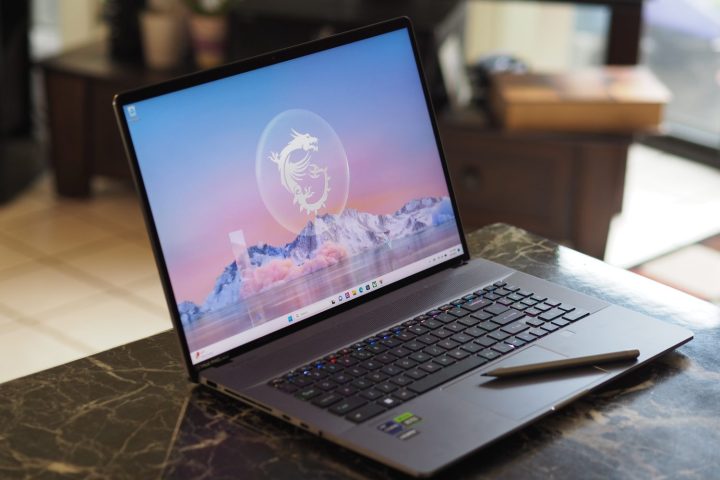
There’s absolutely nothing wrong with the Creator Z17’s design. In fact, there’s quite a bit that’s right about it. It sports small display bezels with a 95% screen-to-body ratio, which is excellent and means it packs its 17.0-inch display into a reasonably sized chassis. It’s not thick for such a large machine at just 0.75 inches and it weighs 5.49 pounds. That’s heavy, but not overly so. The older MSI Creator Z16P is equally thick and weighs 5.27 pounds, making it feel much denser with its 16.0-inch display.
The Creator Z17 is fashioned from aluminum and is as solid as the best laptops. It matches the rigidity of the Dell XPS 15 and Apple MacBook Pro 16, and it gives off a quality feel. The chassis is fairly nondescript, with sleek enough lines and some framing around the keyboard deck to keep it from being boring.
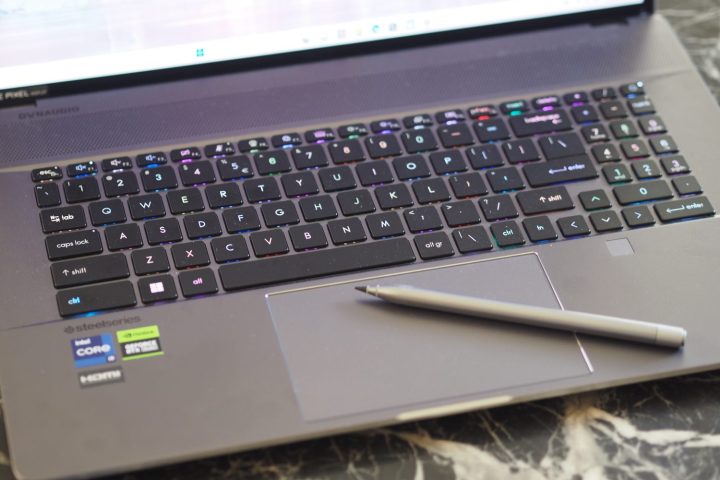
The SteelSeries keyboard has per-key RGB lighting, which is incongruous with the laptop’s non-gamer aesthetic. There’s nothing wrong with offering it, but it seems superfluous. The keyboard has plenty of spacing, with comfortable keycaps, and its switches are a little less springy than I like but still provide accurate typing without generating fatigue.
The touchpad isn’t as large as it could be given the massive speaker grille above the keyboard that takes up a lot of space. It would have been better to shrink that and afford a larger touchpad. The buttons are pretty deep, meaning you really need to push down hard to activate them, and they’re very biased toward the bottom of the touchpad. It’s neither the best nor the worst one I’ve tested.
Connectivity is acceptable for a large laptop, with Thunderbolt 4, USB-A for legacy support, and HDMI 2.1 for connecting an external display at up to 8K at 60Hz or 4K at 120Hz. The full-size SD card slot is also welcome. Wi-Fi 6E and Bluetooth 5.3 are fully modern.
The webcam is 1080p with an infrared camera for Windows 11 Hello support. There’s also a fingerprint reader if you prefer that method for logging in.
Strangely enough, for a clamshell laptop, the Creator Z17 has the most advanced touch technology available, and it works extremely well. It also supports the MSI Pen 2, which is the most advanced on the market. The pen has haptic feedback for a more realistic feel of pen against paper, and not only that, but the tip can be used both for writing on the display and on real paper. I found the experience on paper underwhelming, with very light strokes that are a little hard to read. But it’s there if you need it.
If you pair via Bluetooth, you can also use a remote presentation mode to control slides. The pen’s not the easiest to use in an upright position, but if that’s something you’re into, then you’ll love it.
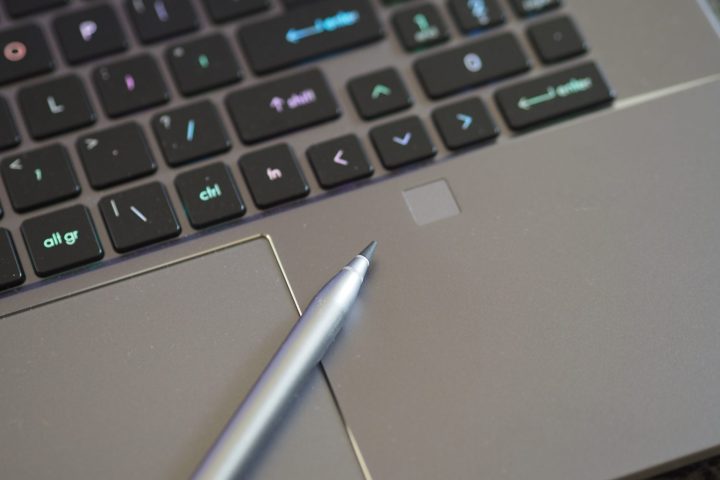
A nearly creator-level display
The Creator Z17 performs like a machine aimed at demanding creators, and it deserves a display that can meet the same users’ needs. Unfortunately, its 17-inch QHD+ IPS panel falls a little short, although its 165Hz refresh rate is great for gamers.
According to my colorimeter, the display is plenty bright at 459 nits. Its contrast is good at 1,130:1, where anything greater than 1,000:1 exceeds the premium laptop threshold. But IPS displays have been getting better, and that’s no longer the great score that it once was. Certainly, it’s nowhere near the deep contrast and inky blacks of OLED and mini-LED displays. But where the panel is least impressive is in its color gamut support. It hits 100% of sRGB and 98% of DCI-P3, but can only handle 88% of the AdobeRGB gamut. That’s less than demanding creators working with photos want to see. It’s an accurate display at a DeltaE of 1.03. which is just on the border of the 1.0 or less that’s considered excellent.
I’d rate the Creator Z17’s display as just good enough for most creators, while the most demanding pros will be disappointed with the colors. For everyone else, including productivity users, media consumers, and gamers, it’s a great display.
Audio was very good, with four speakers pumping out plenty of volume. Mids and highs were clear without any distortion, and there was a touch of bass. The MacBook Pro still has the best audio in a laptop today, but the Creator Z17 is close to the top among Windows laptops.
On the cusp of being a great laptop
There’s a lot to like about the Creator Z17 HX Studio. It’s well-built, nicely sized for a 17-inch laptop, and it provides solid performance for creators and gamers. But its display is just a bit less colorful than the most demanding creators want to see, and its RTX 4070 GPU can’t keep up with some of the faster machines available.
Even so, it’s a competitive laptop at its $3,60o price, and it will satisfy most people with its performance and display quality. I’ll give it a recommendation, but suggest you look closely at the competition before pulling the trigger.
Editors’ Recommendations



